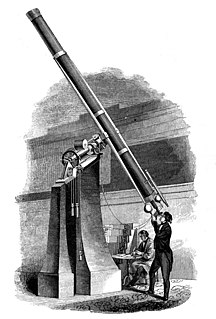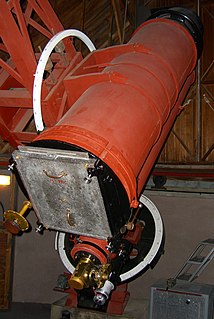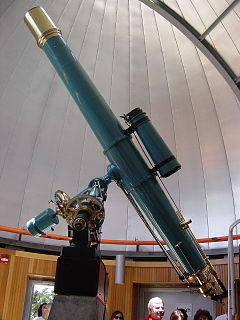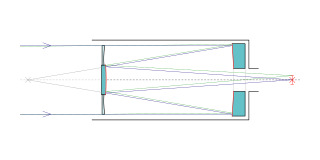
A Ritchey–Chrétien telescope is a specialized variant of the Cassegrain telescope that has a hyperbolic primary mirror and a hyperbolic secondary mirror designed to eliminate off-axis optical errors (coma). The RCT has a wider field of view free of optical errors compared to a more traditional reflecting telescope configuration. Since the mid 20th century, a majority of large professional research telescopes have been Ritchey–Chrétien configurations; some well-known examples are the Hubble Space Telescope, the Keck telescopes and the ESO Very Large Telescope.

A refracting telescope is a type of optical telescope that uses a lens as its objective to form an image. The refracting telescope design was originally used in spy glasses and astronomical telescopes but is also used for long focus camera lenses. Although large refracting telescopes were very popular in the second half of the 19th century, for most research purposes the refracting telescope has been superseded by the reflecting telescope which allows larger apertures. A refractor's magnification is calculated by dividing the focal length of the objective lens by that of the eyepiece.

The Southern Astrophysical Research (SOAR) telescope is a modern 4.1-meter (13 ft) aperture optical and near-infrared telescope located on Cerro Pachón, Chile at 2,738 metres (8,983 ft) elevation. It was commissioned in 2003, and is operated by a consortium including the countries of Brazil and Chile, Michigan State University, the Cerro Tololo Inter-American Observatory (CTIO), and the University of North Carolina at Chapel Hill. Partners have guaranteed shares varying from 10 to 30 percent of the observing time.

A catadioptric optical system is one where refraction and reflection are combined in an optical system, usually via lenses (dioptrics) and curved mirrors (catoptrics). Catadioptric combinations are used in focusing systems such as searchlights, headlamps, early lighthouse focusing systems, optical telescopes, microscopes, and telephoto lenses. Other optical systems that use lenses and mirrors are also referred to as "catadioptric" such as surveillance catadioptric sensors.

An astrograph is a telescope designed for the sole purpose of astrophotography. Astrographs are mostly used in wide field astronomical surveys of the sky and for detection of objects such as asteroids, meteors, and comets.

The Astronomical Observatory of Belogradchik or Belogradchik Observatory is an astronomical observatory owned and operated by the Institute of Astronomy of the Bulgarian Academy of Sciences. It is located near the town of Belogradchik in northwestern Bulgaria, at the foot of the Western Balkan Mountains. The other observatory operated by the same institute is the Rozhen Observatory.

The Vainu Bappu Observatory is an astronomical observatory owned and operated by the Indian Institute of Astrophysics. It is located at Kavalur in the Javadi Hills, near Vaniyambadi in Vellore district in the Indian state of Tamil Nadu. It is 200 km south-west of Chennai and 175 km south-east of Bangalore.

TÜBİTAK National Observatory is a ground-based astronomical observatory operated by the TUG Institute of the Scientific and Technological Research Council of Turkey (TUBITAK). Established in 1991, it is located at an altitude of 2,450 m (8,040 ft) in Bakırtepe, around 50 km (31 mi) west-southwest of Antalya in southern Turkey.

The Nasir al-Din al-Tusi Shamakhi Astrophysical Observatory is an observatory is located in the north-east of the Great Caucasus Mountains,about 22 km far from the centre of Shamakhi, 150 km from Baku in the South Caucasus. Located at a distance. Here, the number of clear lightly nights reaches 150-200 per year.

The Givatayim Observatory is a public observatory that was founded in 1968 by the Israeli Astronomical Association and the Givatayim municipality.

Optical Mechanics, Inc. or OMI is a high-end American telescope and optics instrument manufacturer. OMI was founded in 2002 and produces observatory telescopes, Lidar telescopes, optical tube assemblies, telescope mirrors and reflective coatings for mirrors. OMI mirrors are used by other telescope makers such as Obsession Telescopes. Also taking on custom projects, they produced the 48-inch Dob, a 48.875-inch-diameter (1,241.4 mm) aperture, f/4, Dobsonian telescope called "Barbarella" and featured in Astronomy Technology Today magazine. OMI is located in the US state of Iowa. OMI procured the assets of the former optics company Torus Technologies. OMI has an optics shop where it does work on telescopes.

IUCAA Girawali Observatory is an optical astronomy observatory run by the Inter-University Centre for Astronomy and Astrophysics (IUCAA), Pune. The Observatory is located about 80 km from Pune City, off the Pune Nashik Highway.

The Ankara University Observatory (AUG), is a ground-based astronomical observatory operated by the Astronomy and Space Sciences Department at Ankara University's Faculty of Science. Established in 1959 by Dutch astronomer Egbert Adriaan Kreiken in Ahlatlıbel, Ankara. Currently, it consists of nine optical telescopes and a radio telescope, which is currently taken out of service. Old instruments are displayed in a museum at the observatory.

The Ege University Observatory is a ground-based astronomical observatory operated by the Astronomy and Space Sciences Department at Ege University's Faculty of Science. Formally opened on June 22, 1965, it is located in Kurudağ at Kemalpaşa district, 10 km (6.2 mi) east of Izmir in western Turkey. The telescope domes of the observatory are situated at an altitude of 800 m (2,600 ft) while the main building is erected at 632 m (2,073 ft).

The Ondokuz Mayıs University Observatory is a ground-based astronomical observatory operated by the Astronomy and Space Sciences Department at Ondokuz Mayıs University's Faculty of Science. Established on June 1, 2006, it is located within the university campus at a distance of 14 km (8.7 mi) north-west of Samsun, northern Turkey. It is one of the six university observatories in the country.

The Istanbul University Observatory is a ground-based astronomical observatory operated by the Astronomy and Space Sciences Department at Istanbul University's Faculty of Science. Established in 1936, it is situated next to the historic Beyazıt Tower within the main campus of the university at Beyazıt Square in Fatih district of Istanbul, Turkey.
BlackGEM is a planned array of optical telescopes located at the La Silla astronomical observatory in Chile. This system is specifically designed to detect the optical counterparts from gravitational wave sources detected with Virgo and LIGO. Principal Investigator of the array is Paul Groot.
























